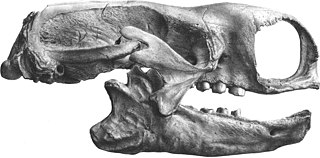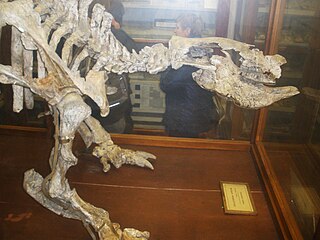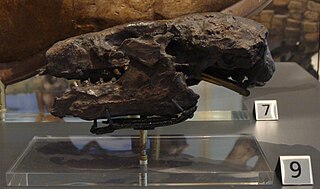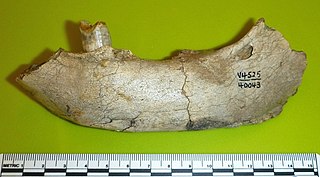
Mylodon is a genus of extinct ground sloth belonging to the family Mylodontidae, known from southern South America. With a total length of 3 to 4 m and a body mass of 1-2 tonnes, it is one of the largest mylodontids.

Ground sloths are a diverse group of extinct sloths in the mammalian superorder Xenarthra. They varied widely in size with the largest, belonging to genera Lestodon, Eremotherium and Megatherium, being around the size of elephants. Ground sloths represent a paraphyletic group, as living tree sloths are thought to have evolved from ground sloth ancestors.

Mylodontidae is a family of extinct South American and North American ground sloths within the suborder Folivora of order Pilosa, living from around 23 million years ago (Mya) to 11,000 years ago. This family is most closely related to another family of extinct ground sloths, Scelidotheriidae, as well as to the extant arboreal two-toed sloths, family Choloepodidae; together these make up the superfamily Mylodontoidea. Phylogenetic analyses based on morphology uncovered the relationship between Mylodontidae and Scelidotheriidae; in fact, the latter was for a time considered a subfamily of mylodontids. However, molecular sequence comparisons were needed for the correct placement of Choloepodidae. These studies have been carried out using mitochondrial DNA sequences as well as with collagen amino acid sequences. The latter results indicate that Choloepodidae is closer to Mylodontidae than Scelidotheriidae is. The only other living sloth family, Bradypodidae, belongs to a different sloth radiation, Megatherioidea.

Scelidotheriidae is a family of extinct ground sloths within the order Pilosa, suborder Folivora and superfamily Mylodontoidea, related to the other extinct mylodontoid family, Mylodontidae, as well as to the living two-toed sloth family Choloepodidae. The only other extant family of the suborder Folivora is the distantly related Bradypodidae. Erected as the family Scelidotheriidae by Ameghino in 1889, the taxon was demoted to a subfamily of Mylodontidae by Gaudin in 1995. However, recent collagen sequence data indicates the group is less closely related to Mylodon and Lestodon than Choloepus is, and thus it has been elevated back to full family status by Presslee et al. (2019).

Glossotherium is an extinct genus of large mylodontid ground sloths of the subfamily Mylodontinae. It represents one of the best-known members of the family, along with Mylodon and Paramylodon. Reconstructed animals were between 3 and 4 metres long and possibly weighed up to 1,002.6–1,500 kg. The majority of finds of Glossotherium date from the Middle and Upper Pleistocene, around 300,000 to 10,000 years ago, with a few dating older, as far back Pliocene, about 3.3-3 million years ago. The range included large parts of South America, east of the Andes roughly from latitude 20 to 40 degrees south, leaving out the Amazon Basin in the north. In western South America, finds are also documented north of the equator. The animals largely inhabited the open landscapes of the Pampas and northern savanna regions.

Lestodon is an extinct genus of giant ground sloth native to South America during the Pleistocene epoch. Its fossil remains have been primarily been found in the Pampas and adjacent regions. The largest member of the family Mylodontidae, It is estimated to have weighed 4,100 kilograms. It was a herbivore and primarily fed on the grasses and low-growing plants.

Catonyx is an extinct genus of ground sloth of the family Scelidotheriidae, endemic to South America during the Pliocene and Pleistocene epochs. It lived from 2.5 Ma to about 10,000 years ago, existing for approximately 2.49 million years. The most recent date obtained is about 9600 B.P.
Orophodon is an extinct genus of ground sloth of the family Mylodontidae, endemic to Argentina, South America.

Scelidodon is an extinct genus of South American ground sloths. Its remains have been found in the Yupoí and Uspara Formations of Argentina, the Ulloma, Umala, Ñuapua and Tarija Formations of Bolivia, in Brazil, in Chile and in Peru. The youngest fossils have been dated to as recently as 9000 B.P.

Valgipes is an extinct genus of scelidotheriid ground sloth, endemic to intertropical Brazil and Uruguay during the Late Pleistocene. Thought to have been a forest-dwelling browser, Valgipes is a monotypic genus with a complex and long taxonomic history, and is a close relative of Catonyx and Proscelidodon.

The Cerro Azul Formation, also described as Epecuén Formation, is a geological formation of Late Miocene age in the Colorado Basin of the Buenos Aires and La Pampa Provinces in northeastern Argentina.

Proscelidodon is an extinct genus of ground sloths in the family Scelidotheriidae. It lived during the Miocene and Pliocene of what is now Argentina and Bolivia. The genus was described in 1935.
Mcdonaldocnus is an extinct genus of nothrotheriid ground sloths that lived during the Middle Miocene and Early Pliocene of what is now Bolivia and Argentina. It was originally placed in the genus Xyophorus but was subsequently recognized as a distinct genus by Gaudin and colleagues in 2022. The authors reassigned the material of "Xyophorus" bondesioi, Xyophorusvillarroeli and Xyophorus sp. to Mcdonaldocnus. Fossils of Mcdonaldocnus have been found in the Cerro Azul Formation of Argentina.
Eucinepeltus is an extinct genus of glyptodont. It lived during the Early Miocene, and its fossilized remains were discovered in South America.

Cochlops is an extinct genus of glyptodont. It lived from the Early to Middle Miocene, and its fossilized remains have been found in South America.
Bolivartherium is an extinct genus of mylodontine mylodontid sloth that lived during the Late Miocene and Late Pliocene in what is now Venezuela. Fossils have been found in the Codore and Urumaco Formations of Venezuela.

Magdalenabradys is an extinct genus of mylodontid ground sloths that lived during the Middle Miocene and Early Pliocene of what is now Colombia and Venezuela. Fossils have been found in the Villavieja Formation of the Honda Group in Colombia, and the Codore and Urumaco Formations of Venezuela.
Neonematherium is an extinct genus of scelidotheriid ground sloths that lived in Argentina, Chile, and Colombia during the Early to Late Miocene. Fossils have been found in the Honda Group of Colombia, and the Río Frías Formation of Chile.
Analcitherium is an extinct genus of scelidotheriid sloth that lived during the Early Miocene in what is now Argentina. Fossils have been found in the Santa Cruz Formation of Argentina.

Ortotherium is a genus of megalonychid ground sloth from the Late Miocene Ituzaingó Formation of Entre Rios Province, Argentina. Although many species were described, the only valid species of the genus is Ortotherium laticurvatum, with many species being junior synonyms. Ortotherium is known from very fragmentary material, all of which is material from the mandible and teeth. The holotype of O. laticurvatum consists of an incomplete left dentary that had been unearthed from a series of sediments known as ‘Conglomerado osifero’ in Paraná, Argentina. Argentina paleontologist Florentino Ameghino named the species in 1885, though he would go on to name four more, invalid, species of the genus. One species however, O. brevirostrum, has been reclassified as Mesopotamocnus.















